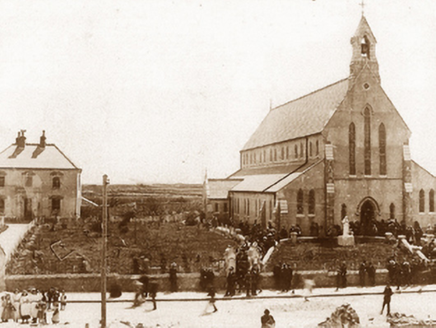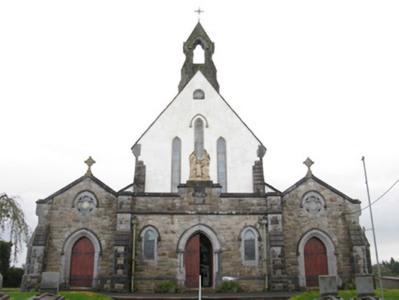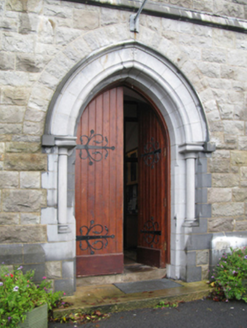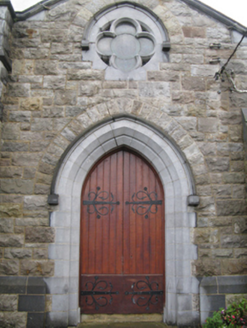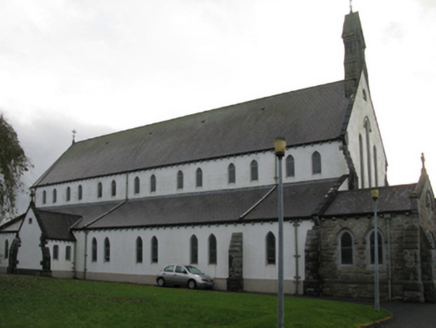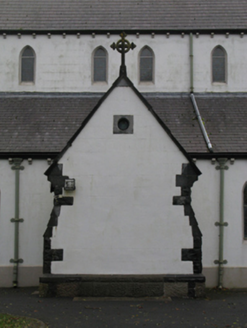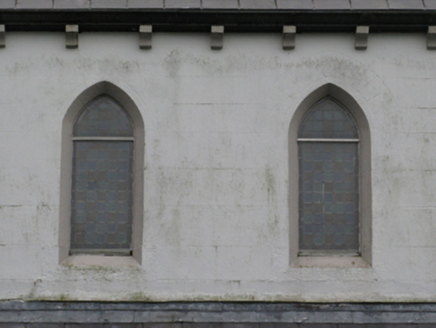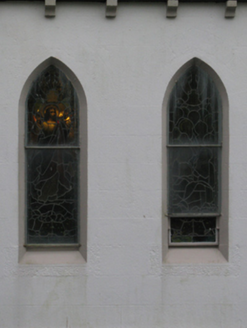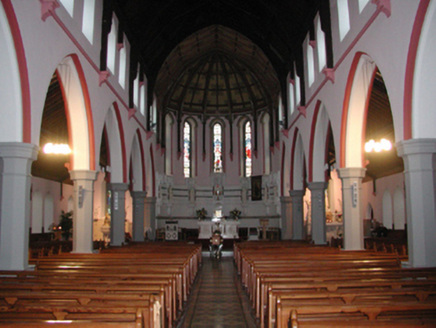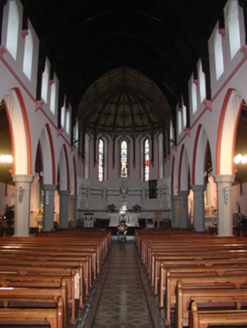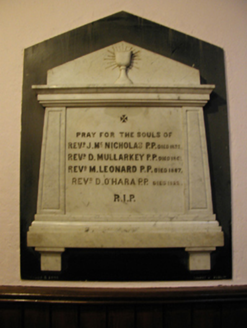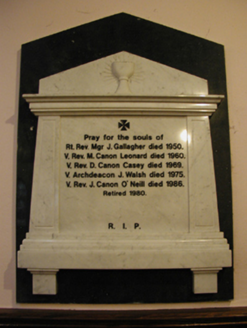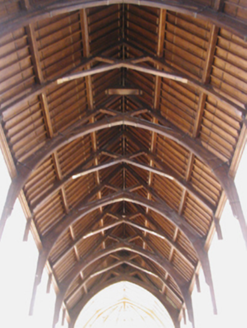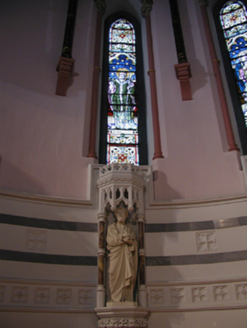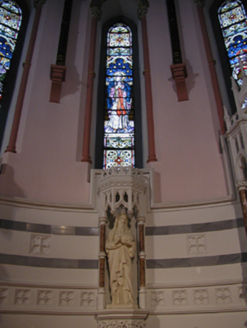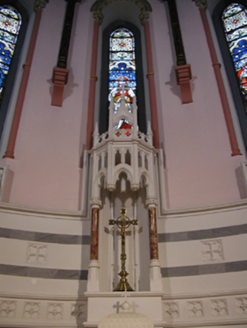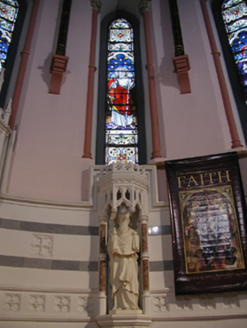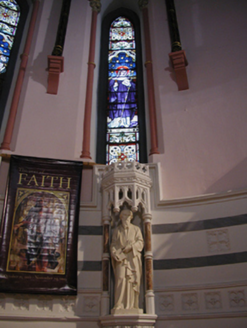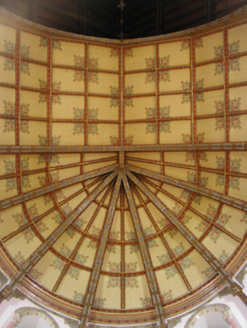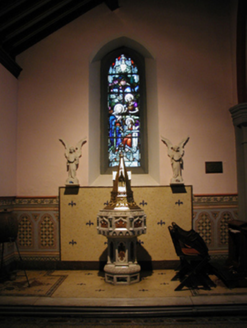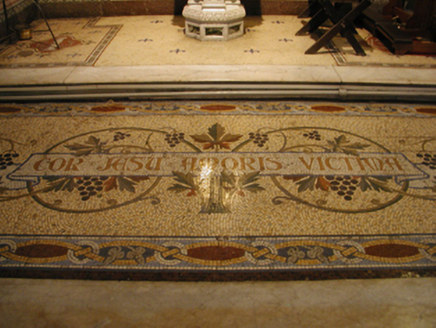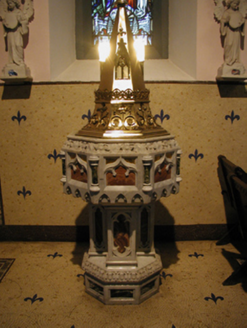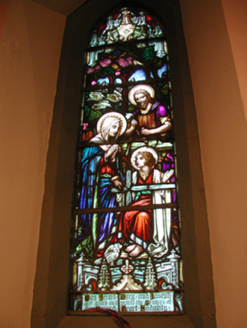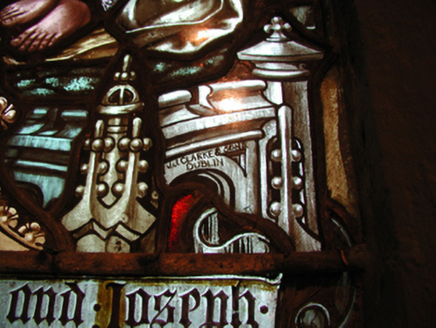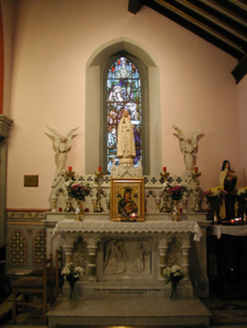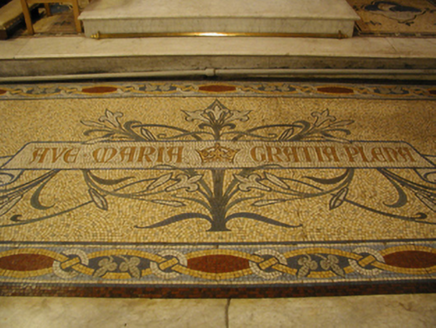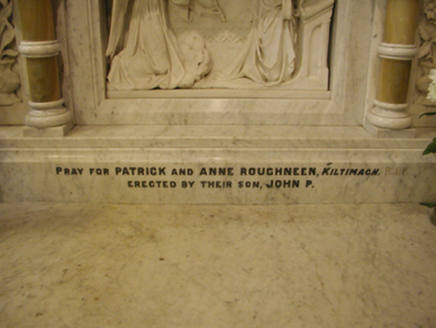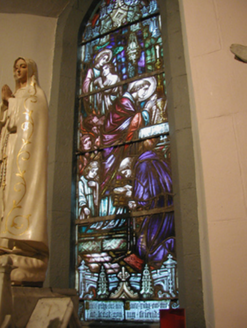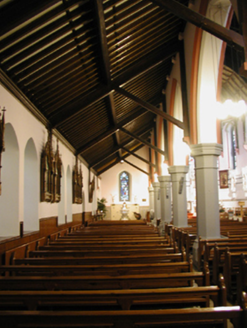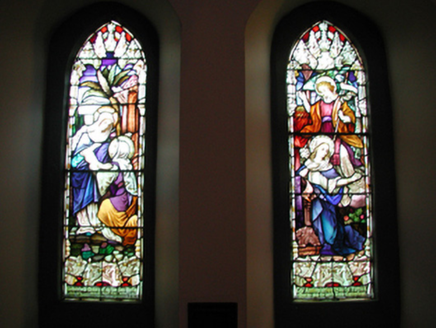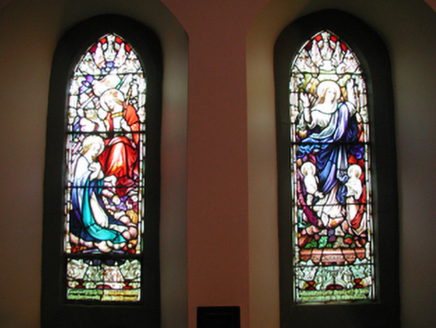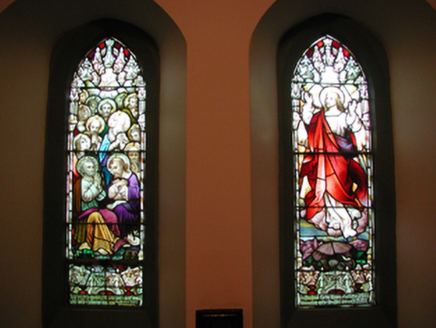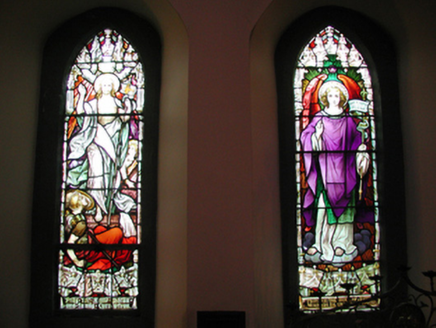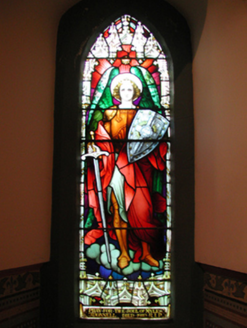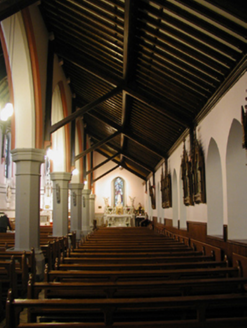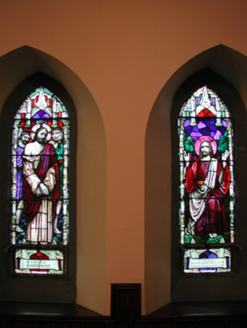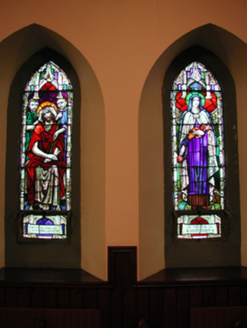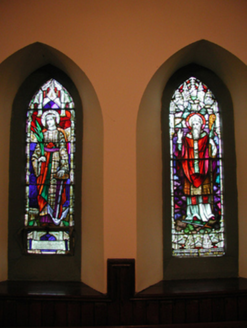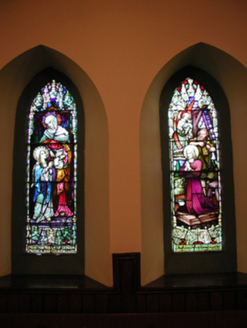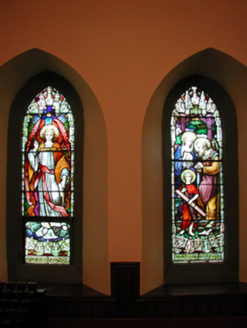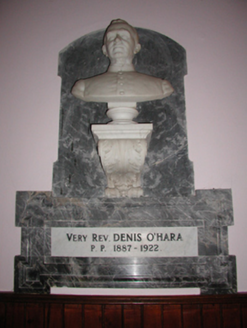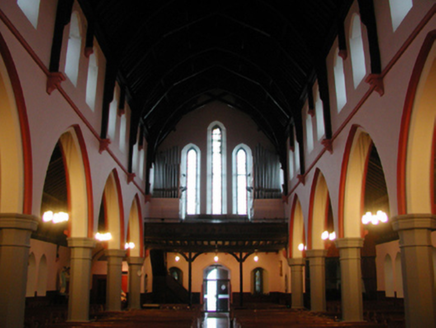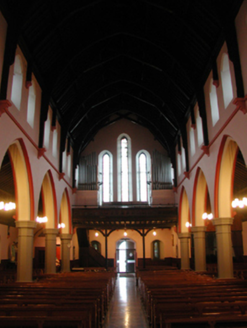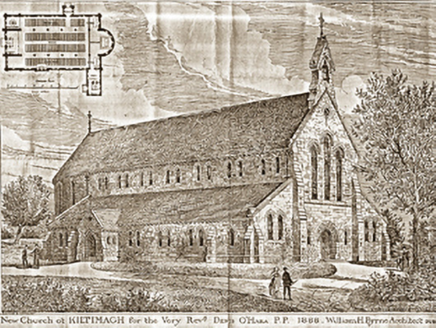Survey Data
Reg No
31210007
Rating
Regional
Categories of Special Interest
Architectural, Artistic, Historical, Social, Technical
Previous Name
Saint Aidan's Catholic Church
Original Use
Church/chapel
In Use As
Church/chapel
Date
1885 - 1890
Coordinates
134143, 289165
Date Recorded
23/11/2010
Date Updated
--/--/--
Description
Detached eight-bay double-height Catholic church, built 1887-8; dated 1888; dedicated 1888; extant 1895, comprising seven-bay double-height nave opening into seven-bay double-height lean-to side aisles centred on single-bay full-height apse (east) on a semi-circular plan with single-bay single-storey gabled projecting porches to entrance (west) front centred on single-bay single-storey flat-roofed projecting porch. "Improved", 1914-6, producing present composition. Renovated, 1982, with sanctuary reordered. Reroofed, 1998. Replacement pitched slate roof with lean-to slate roofs to side aisles, clay ridge tiles terminating in wrought iron Cross finial to apex (east), cut-limestone "slated" coping to gable to entrance (west) front on drag edged tooled cut-limestone corbel kneelers with tuck pointed drag edged dragged limestone ashlar buttressed gabled bellcote to apex, and uPVC rainwater goods on cut-limestone "Cavetto" consoles retaining cast-iron octagonal or ogee hoppers and downpipes with rosette-detailed straps. Rendered, ruled and lined walls on rendered chamfered plinth with drag edged rock faced cut-limestone clasping buttresses to corners having drag edged tooled cut-limestone "slated" coping. Paired lancet window openings (clerestorey) with drag edged tooled cut-limestone flush sills, and concealed dressings having chamfered reveals framing storm glazing over fixed-pane fittings having stained glass margins centred on square glazing bars. Paired lancet window openings (side aisles) with drag edged tooled cut-limestone flush sills, and concealed dressings having chamfered reveals framing storm glazing over fixed-pane fittings having stained glass margins centred on leaded stained glass panels. Lancet window openings to apse (east) with concealed dressings having chamfered reveals framing storm glazing over fixed-pane fittings having stained glass margins centred on leaded stained glass panels. Lancet "Trinity Window" to entrance (west) front, concealed dressings having chamfered reveals with hood moulding over on label stops framing storm glazing over fixed-pane fittings having stained glass margins centred on square glazing bars. Pointed-arch central door opening with step threshold, drag edged dragged cut-limestone block-and-start having colonette-detailed reveals with hood moulding over on monolithic label stops framing timber boarded or tongue-and-groove timber panelled double doors. Lancet flanking window openings, drag edged dragged cut-limestone block-and-start surrounds having chamfered reveals with hood mouldings over on monolithic label stops framing storm glazing over fixed-pane fittings having stained glass margins centred on leaded stained glass panels. Interior including vestibule (west); pointed segmental-headed door opening into nave with replacement glazed double doors having overlight; full-height interior open into roof with pair of cut-white marble Classical-style wall monuments (ob. 1832; 1950), perforated timber panelled organ gallery (west) on bull nose-detailed timber posts supporting timber panelled pipe organ centred on "Trinity Window", glazed tiled central aisle between timber pews, pointed-arch arcades on drag edged dragged limestone ashlar octagonal pillars, exposed pointed-arch braced scissor truss timber roof construction on "Cavetto"-detailed "Bowtell" corbels with wind braced rafters to timber boarded ceiling on carved timber cornice, pointed-arch "floating" chancel arch on Corinthian colonettes on "Cavetto"-detailed "Bowtell" corbels framing mosaic tiled cut-veined white marble stepped dais to sanctuary (east) reordered, 1982, with carpeted stepped "predella" supporting cut-veined white marble Gothic-style altar (1914) below stained glass windows (undated), stencilled polygonal vaulted ceiling in carved timber frame on carved timber cornice, mosaic tiled cut-veined white marble stepped daises to side altars with cut-veined white marble Gothic-style baptismal font (1914; north) or cut-veined white marble Gothic-style memorial altar (1914; south) below stained glass memorial windows (undated), timber boarded or tongue-and-groove timber panelled wainscoting to side aisles supporting carved timber dado rail, paired Gothic-style timber stations between paired stained glass memorial windows (ob.1850-1922), and exposed strutted timber roof construction on "Cavetto" corbels with wind braced rafters to ceiling on carved timber cornice. Set in landscaped grounds on a slightly elevated site.
Appraisal
A church erected to a design by William Henry Byrne (1844-1917) of Dublin (Irish Builder 1889, 74) representing an important component of the late nineteenth-century built heritage of County Mayo with the architectural value of the composition, one recalling the contemporary Catholic Church of Our Lady Help of Christians (1889-91), Swinford (see 31207011), confirmed by such attributes as the rectilinear plan form, aligned along a liturgically-correct axis; the slender profile of the coupled openings underpinning a "medieval" Gothic theme with the "West Front" defined by an elegant "Trinity Window"; and the handsome bellcote embellishing the roofline as a picturesque eye-catcher in the landscape: meanwhile, aspects of the composition clearly illustrate the continued development or "improvement" of the church to a design supplied (1914) by William Henry Byrne and Son (formed 1902) of Suffolk Street, Dublin (Irish Builder 1916, 153). Having been well maintained, the elementary form and massing survive intact together with substantial quantities of the original fabric, both to the exterior and to the interior reordered (1982) in accordance with the liturgical reforms sanctioned by the Second Ecumenical Council of the Vatican (1962-5) where an unsigned effigy of Reverend Denis O'Hara PP (1850-1922; fl. 1887-1922); contemporary joinery; mosaic work attributed to Earley Studios Limited (closed 1975) of Dublin (Williams 1994, 305); vibrant stained glass signed by Joshua Clarke and Sons (established 1892) of North Frederick Street, Dublin; and stencil work attributed to the McHugh Brothers of Kiltimagh, all highlight the considerable artistic potential of the composition: meanwhile, an exposed timber roof construction pinpoints the engineering or technical dexterity of a church forming part of a neat self-contained group alongside the adjacent parochial house (see 31210008) with the resulting ecclesiastical ensemble making an imposing visual statement in the streetscape.
